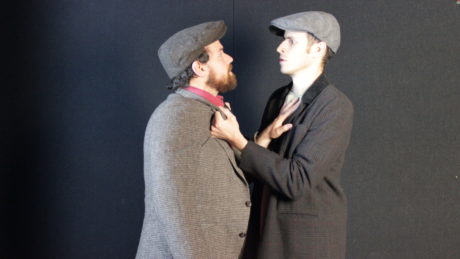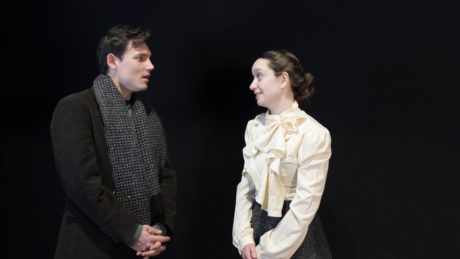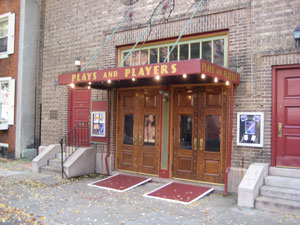Exactly 100 years ago, a group of Irish poets, musicians, writers and dreamers seized the Dublin Post Office, (yes, that’s right, the Post Office) in an ill conceived attempt to surprise the occupying British and bring Home Rule to Ireland. The rebellion was brutally crushed, but Ireland being Ireland, these events have lived on in evocative poems, songs, and plays.

Sean O’Casey, a true poet of the people, wrote a trilogy of plays based on this turbulent era. The first two, Shadow of a Gunman, and Juno and the Paycock, have been produced by the Irish Heritage Theater, in co-production with the Plays and Players Theater. Now, again under the direction of Peggy Mecham, the trilogy is completed with The Plough and the Stars. This final play, the only one actually set during the Easter Uprising, is a difficult project demanding four settings, and a large cast that must be skilled in a specific Dublin dialect. The heart is in the right place.
Modern theatergoers accustomed to the current fad of the 90-minute play will find O’Casey tough going. He does not actually dramatize the Uprising, instead setting the action in tenements and pubs, peopled with characters who have little perspective on the events surrounding them. Nothing much happens in the first half-hour. It is rather like spending some time having tea with the poor city dwellers of 1915.
These characters are classics of Irish Drama. There is Nora (Victoria Rose Bonito) a young housewife, who hates the rebellion. She only wants make a life with her new husband. There is Young Covey (Kevin Rodden) a misguided firebrand communist who believes he has all the solutions. There is Rose, (Kyra Baker) a prostitute who finds revolution is bad for business. And Bessie (Mary Pat Walsh) a Protestant whose son is fighting the war in Germany, who sings “Rule Britannia” frequently, but has more heart than all of the rest of them. Most memorable is Fluther (John Shultz) the common man trade unionist who comically changes his views frequently and represents what many Dubliners may have thought of the episode.
The cast is likable, and if you are experienced in O’Casey’s thick dialogue, laden with obscure local references, it is easy to see they are making a noble effort. Bonito and Harry Watermeier make a fine romantic couple, and Bonito even pulls off a traditional “mad in white linen” scene. Jimmy Guckin and Eric Dann make a strong impression as visiting English soldiers who are totally clueless about the political situation.
Best of all is Mary Pat Walsh as Bessie, who captures all the pain and complexity of this amazing woman. Much humor is lost in the arguments between Young Covey and Fluther. These actors are miscast, and completely at sea in their roles. Other memorable tenement dwellers are played by John Cannon, Michelle Pauls, and Barbaraluz Orlanda.
Much of the power of The Plough and the Stars comes form the invasion of the outside world onto typical tenement life. As the play continues, the war invades everything. This aspect is weakly handled in Peggy Mecham’s production, which lacks theatrical force. The great scene at the end of the first act, when the “Starry Plough” flag is introduced, is handled so perfunctorily that you’d never know it was the climax of the act.
Tenement existence is a beehive teemomg with life. Space is cramped, so people use their neighbors’ rooms, the streets and the pubs as extensions of their living rooms. Each scene has many characters trying to make the best of life in trying circumstances. If ever a play needed a design that reflected the very specific time and places of the era this is it. Designer Teddy Moseanu, (with Director Mecham) has provided almost no set. A few anachronistic props stand in isolation on the large stage. Windows are very important to the plot of this play, and here they are sticks of wood mounted on two by fours. There is no sense of location, character, or activity. Director Mecham uses only the props called for in the script, which leaves the actors standing around waiting for their cues. These performers would benefit from, low budget aside, more imaginative floor plans and staging.
Mark B. Knight makes quite an impression in the Padraic Pearse role of the war-mongering rabble-rouser. Placing him in the middle of the auditorium certainly blunted the author’s intent.
Alexis Mayer has provided projections that cannot be seen on the black back wall. Kassy Bradford’s costumes capture the lower class feel, though the uniforms lack specificity. The rehearsal room atmosphere is completed with dead-on white front lighting, which provides indifferent atmosphere.

Visitors to Dublin are frequently surprised to discover that the current Abbey Theatre is a non-descript modern stage. Entering the Plays and Players Theatre, built in 1913, seems to provide exactly the right ambiance of what it must have been like to attend the Old Abbey in 1926.

Running Time: Two hours and 30 minutes, with an intermission.
The Plough and the Stars plays through Saturday June 11, 2016, at the Irish Heritage Theatre and The Plays and Players Theatre performing at The Plays and Players Theatre – 1714 Delancey Place, in Philadelphia. For tickets call (215) 735-0630, or purchase them online.




